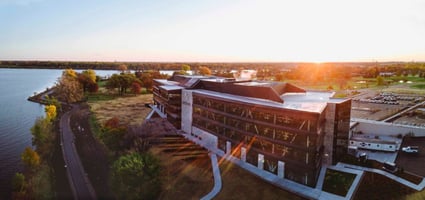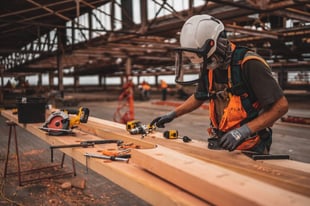The Top 4 Construction Buzzwords for 2023
What is the next big thing in construction? What do precon teams need to be preparing for? Although inflation, material costs and supplies, and the labor shortages are still predicted to be a big problem for contractors in 2023, there is light at the end of the tunnel. According to all the industry reports released so far this year, there are quite a few trends in the construction industry to look forward to.
The following 4 words are ones you should familiarize yourself with if you want to stay on top of your game in 2023:
- Digitization
- CHIPS Act
- Sustainability
- Diversified workforce
Digitization 
What is digitization? Digitization is the process of transferring information to a computer so the computer can store, process, and recall it. In business, digitization means using technology, like computers and other digital technologies to change a process or processes to increase your efficiency and revenue.
There are many different innovative technologies in use in construction—automation and artificial intelligence (machine learning), robotics, cloud-based software, drones, virtual construction like BIM, and many more.
Teams using these new technologies are getting more accurate information about projects, construction sites are safer, better buildings are being built under cost, communication is improved, and the entire preconstruction and construction process is getting more efficient.
For example, studies from Dodge Data & Analytics found that GCs using BIM on more than half of their projects improve schedule performance by 60% and improve budget performance by 50% over contractors who do not use BIM.
You don’t have to take anonymous reports as the only evidence. PARIC Corporation, an ENR Top 400 Contractor, uses estimating software, drones, and laser scanners to help drive project decisions and build trust with owners. Andy Leek, Vice President of Technology and Innovation at PARIC, says these technologies help explain and defend why certain decisions were made.
Overall, total construction starts rose 17% in 2022 and are expected to remain flat in 2023 – a relatively optimistic forecast for a period of anticipated economic stagnation. -Construction market forecast 2023 | Equipment World
The CHIPS and Science Act of 2022
![]() One of the major problems in our supply chain is access to semiconductors. Semiconductors are necessary to build computers, cell phones, cars, and countless other things we use every day. 80% of all the world’s semiconductors are manufactured overseas.
One of the major problems in our supply chain is access to semiconductors. Semiconductors are necessary to build computers, cell phones, cars, and countless other things we use every day. 80% of all the world’s semiconductors are manufactured overseas.
To combat this issue, President Joe Biden signed a $280 billion spending bill called the CHIPS and Science Act to help stimulate the manufacturing of semiconductors in the United States. This is where the construction industry comes in…the act includes $39 billion in incentives for U.S. companies to build new microchip manufacturing plants.
There are already five companies taking advantage, including Samsung’s 11 new chip plants located in Texas, and a $20 billion new Intel plant in Ohio.
In praise of the CHIPS Act, Richard Branch, chief economist for Dodge Data & Analytics, says it is going to “keep the construction sector on sure footing as the economy slows over the next year."
Sustainability 
Sustainable construction. Green building. Call it what you will but it is estimated that by 2025, “over 60 percent of all new buildings could be labeled net-zero ready—or capable of being built with zero carbon emissions.” (Top 5 Construction Industry Trends for 2023 (armacell.us) The pressure is on from owners, too. They want contractors that use the most “cutting-edge products, innovations and delivery methods…”. They want buildings with lower carbon footprints, and that are more energy efficient. “Today, you don’t sacrifice returns for sustainability, you create returns with sustainability,” says Stephen Tross, Chief Investment Officer at Bouwinvest, a firm with $17 billion in assets.
The benefits of green building are numerous. Not only does it improve the construction industry’s negative impact on the environment, but also, it’s profitable. Residential LEED-certified projects have a higher occupancy rate, have less turnover, and produce 3.7% more rent.
Jessica Morris, Turntide Technologies Director of Product Marketing for Built Environments says, “Buildings that are green, or more sustainable, tend to have higher occupancy rates and lower turnover and command higher rents. So, there’s a strong business case for embracing sustainability. Owners who act now to make their buildings more environmentally friendly will see a competitive advantage; those who fail to do so will get left behind.”
Profitable owners equal profitable general contractors.
For more on green building and sustainability, read the following blog posts:
- 3 Reasons to Build Green
- How Sustainable Construction Can Transform Communities
- Benefits and Emerging Trends in Sustainable Construction
- Sustainability and Alternative Materials in Preconstruction
Diversified Workforce
 In the 2023 Engineering and Construction Industry Outlook report collected by Deloitte US, it was found that “more than 82% of survey respondents mentioned a tight labor market and an exiting workforce as one of their company’s top challenges in the next year.” This means that contractors need to think outside the box when it comes to recruiting.
In the 2023 Engineering and Construction Industry Outlook report collected by Deloitte US, it was found that “more than 82% of survey respondents mentioned a tight labor market and an exiting workforce as one of their company’s top challenges in the next year.” This means that contractors need to think outside the box when it comes to recruiting.
One of these ways is working to create a diversified workforce. When we talk about a diversified workforce, we aren’t just talking about the legal protected classes, but also embracing different backgrounds and experiences, and diverse thoughts. Companies with a diverse workforce are more creative and innovative.
A diverse workforce enhances your company’s culture and demonstrates fairness, inclusion, and as Tracy Sanders, Social Responsibility and Community Development at Sundt Construction says, employees know they have ‘a seat at the table.’ When an employee feels they can bring their full selves to work, it creates “fulfillment for individuals,” says Tracy. Fulfillment, happiness, and satisfaction are key to retaining employees.
As a bonus, multiple studies show that more diverse companies outperform companies that aren’t.
Companies also need to be attractive to and sell themselves to potential employees. This means reevaluating your company’s culture, tech stack, and salary ranges. People want more flexibility, a better work/life balance, and a company that embraces innovative technologies that help people work more efficiently.
At Beck Tech, we often discuss how we, as an industry, can make precon “sexy” and your tech stack is a critical part of attracting new talent. As we like to say, “estimating is an art” and every estimator would much rather use their artistic skills rather than spend hours clicking and dragging, copying, and pasting, and redoing work.
Though our industry still faces some tough challenges in the year ahead, fortunately, new trends and innovative technologies are helping to mitigate those challenges. What are some of the challenges you’re facing in your market and what are you doing to solve those problems? Shoot us an email at info@beck-technology.com and let’s talk about it.
-1.png?width=112&height=112&name=image%20(4)-1.png)














